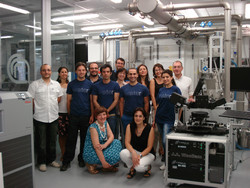WATER researchers reveal promising candidates for water treatment and purification
The FP7-funded WATER project – which aims to unlock the research potential of the CNR (the Italian National Research Council) in Catania in the application of nanotechnology to water treatment – has supported important research into semiconductor photocatalytic processes as a water treatment technology. And the findings were recently published by the International Society for optics and photonics – SPIE(opens in new window). Semiconductor photocatalytic processes have shown great potential as a water treatment technology. This methodology can be used to remove persistent organic compounds and micro-organisms that are found in water. Zinc oxide (ZnO) has been shown to be a particularly promising material for this technology. There are, however, some drawbacks to the use of photocatalytic semiconductors that limit their application for large-scale photocatalytic processes. Firstly, they have a high recombination rate of photogenerated electron-hole pairs and secondly, the catalyst particles exhibit poor recovery after water treatment. Supported by WATER, researchers from CNR-IMM (Institute for Microelectronics and Microsystems) investigated ways to address both of these issues associated with photocatalytic semiconductors. The research team notes, ‘We have conducted a series of UV irradiation tests on novel ZnO-coated Fe2O3 core-shell nanostructures. Our results show that these substances are promising candidates for photocatalytic applications (e.g. for water treatment and purification).’ The CNR team is now planning to conduct further studies to help optimize the photocatalytic activity of synthesized nanostructures. The researchers are also planning to investigate the antibacterial activity of our materials against Escherichia coli, which is a common indicator of fecal contamination in water. The work aims ultimately to contribute towards addressing the major research challenge of providing our growing global population with clean, safe and easy access to drinking water. This will be no mean feat. As things stand, 1.2 billion people worldwide have inadequate access to clean water, and tragically, every minute a child dies of a water-related disease. One field which is expected to help improve water filtration with lower cost and energy is nanotechnology, and that’s why this is the focus of the WATER project. This most recent WATER study which is titled, ‘Core-shell nanostructures with promising photocatalytic characteristics’, is the latest in a series of research papers supported by the project. Apart from investigating metallic oxides nanostructures, the project is also supporting research which explores how metallic nanostructures and carbon-based materials can be fruitfully applied for water treatment. Project coordinator Vittorio Privitera notes, ‘The project’s findings are significant because water is the second most important problem facing humanity, after energy. According to the Nobel prize-winner Richard E. Smalley and the United Nations, in 30 years half of the world population will suffer from a lack of clean water. With this project, we are trying to address this mammoth challenge. And now the European Commission has published a call for proposals named H2020-WATER to reinforce European efforts to tackle such problems.’ For further information, please visit: WATER http://www.water.imm.cnr.it/index.php?lang=en(opens in new window)
Countries
Italy



